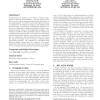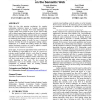306 search results - page 42 / 62 » How knowledge workers use the web |
ICWSM
2009
13 years 5 months ago
2009
The advent of social tagging systems has enabled a new community-based view of the Web in which objects like images, videos, and Web pages are annotated by thousands of users. Und...
CIKM
2010
Springer
13 years 6 months ago
2010
Springer
In this paper, we present a novel entity coreference algorithm for Semantic Web instances. The key issues include how to locate context information and how to utilize the context ...
WWW
2008
ACM
14 years 8 months ago
2008
ACM
An infosuasive web application is mainly intended to be at the same time informative and persuasive, i.e., it aims at supporting knowledge needs and it has also the (declared or n...
WWW
2005
ACM
14 years 8 months ago
2005
ACM
While the idea that querying mechanisms for complex relationships (otherwise known as Semantic Associations) should be integral to Semantic Web search technologies has recently ga...
SIGMOD
2009
ACM
14 years 8 months ago
2009
ACM
Mashup is a new application development approach that allows users to aggregate multiple services to create a service for a new purpose. Even if the Mashup approach opens new and ...


